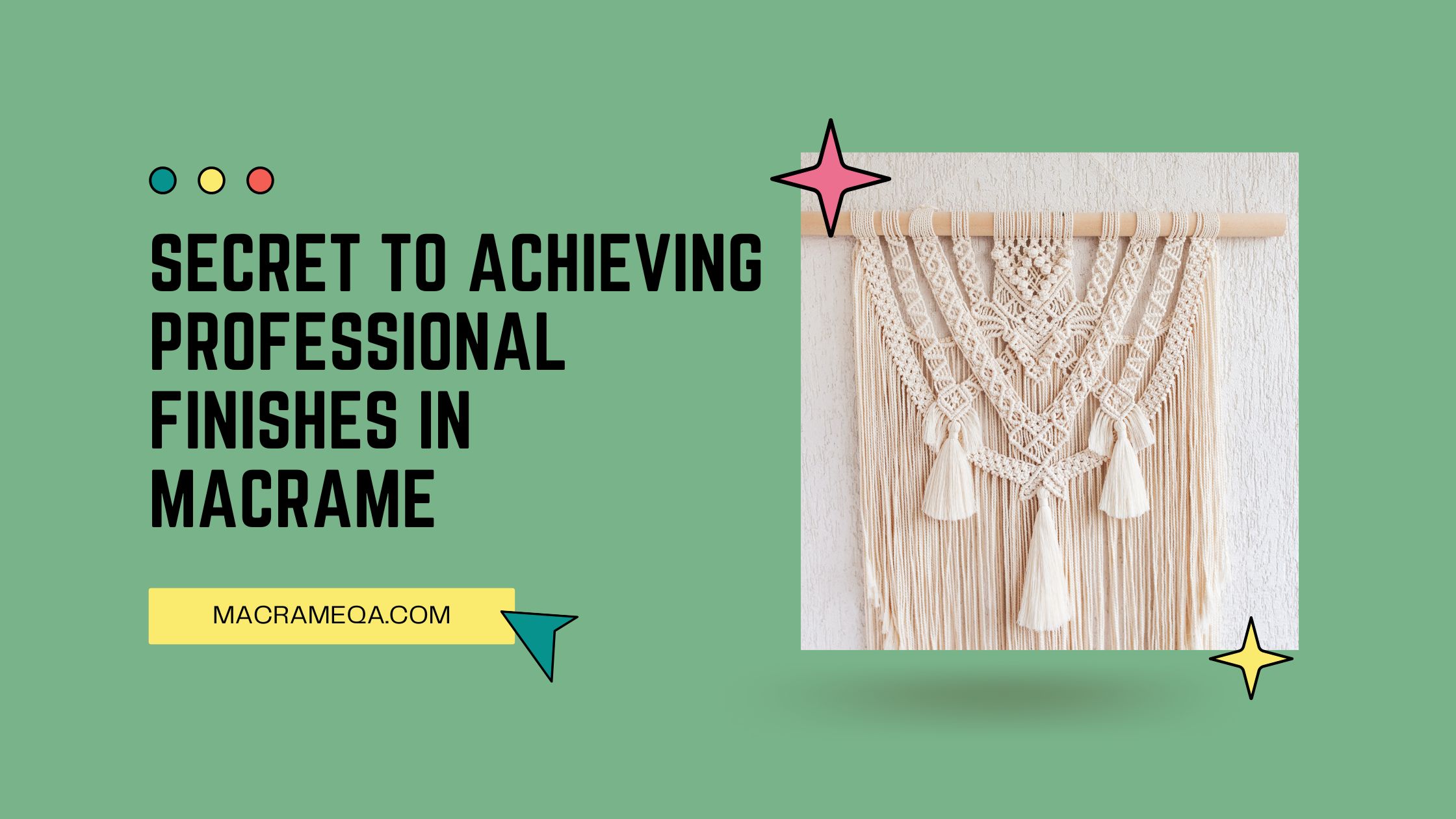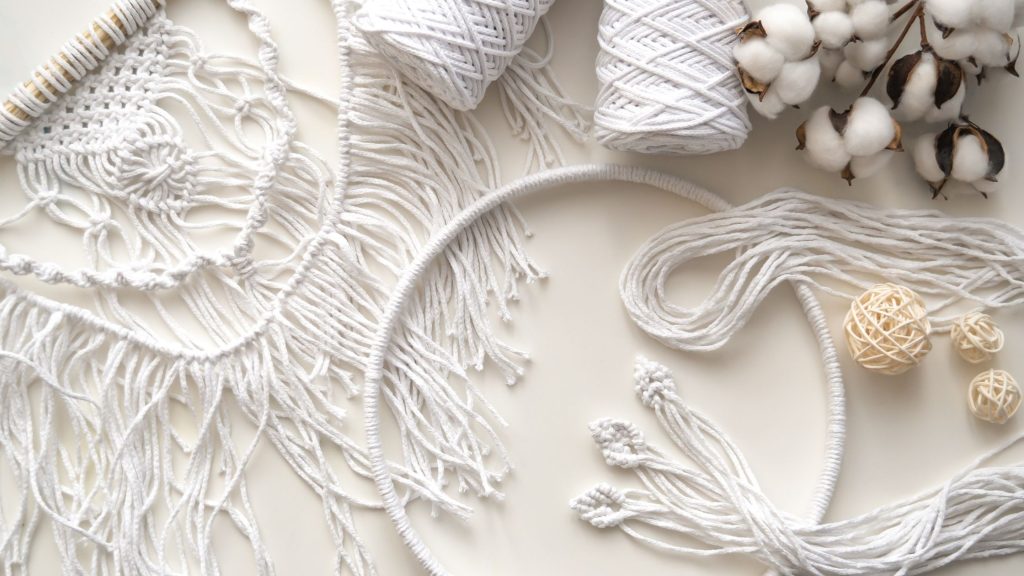You’ve probably admired those intricate and beautifully finished macrame creations, wondering how on earth they achieved such a polished look. Well, wonder no more! In this article, we’ll unlock the secret to achieving professional finishes in macrame, divulging tips and techniques that will take your handmade creations to the next level. Whether you’re a beginner or a seasoned macrame enthusiast, get ready to elevate your skills and create stunning pieces that will make everyone ask, “How did you do that?”
Choosing the Right Materials
When it comes to macrame, one of the first steps in achieving professional finishes is choosing the right materials. The type of cord you use can greatly impact the overall look and feel of your macrame piece. There are several different options to consider when selecting the type of cord, such as cotton, hemp, nylon, or jute. Each material has its own unique qualities and textures, so it’s important to choose one that aligns with the vision you have for your project.
Selecting the Right Type of Cord
Cotton cord is a popular choice among macrame artists due to its softness and versatility. It is easy to work with and creates beautiful, delicate knots. Hemp cord, on the other hand, is a more rugged option that adds a rustic touch to your macrame piece. Nylon cord is known for its durability and strength, making it ideal for larger or outdoor projects. Jute cord provides a natural and textured look, perfect for creating a bohemian or beachy vibe.
Before making a decision, consider the overall aesthetic you want to achieve and the purpose of your macrame piece. If you’re unsure, don’t hesitate to experiment with different types of cord to see which one resonates with you the most.
Considering the Thickness of the Cord
Aside from the type of cord, the thickness is another important factor to consider when aiming for professional finishes in macrame. Thicker cords tend to create bulkier and more prominent knots, while thinner cords allow for more intricate and delicate designs. It’s crucial to strike a balance between the thickness of the cord and the complexity of your design. If you’re working on a smaller project, a thinner cord may be more suitable, as it allows you to manipulate the knots with greater precision. For larger projects, a thicker cord can create a bold and eye-catching statement.
Consider the scale of your design, the level of detail you want to achieve, and the overall look you’re going for. By carefully selecting the appropriate thickness of cord, you can ensure that your macrame piece has a professional and polished finish.
Exploring Different Fiber Options
In addition to cord type and thickness, exploring different fiber options can also enhance the overall appearance of your macrame piece. Natural fibers such as cotton and hemp provide a soft and organic look, while synthetic fibers like nylon can offer a sleek and modern feel. By incorporating various fiber options into your macrame designs, you can add depth, texture, and visual interest.
Consider mixing different fibers within a single project to create contrast and dimension. For example, you can combine a cotton cord with a metallic nylon cord to add a touch of glamour to your macrame piece. Additionally, you can experiment with dyed or stained cords to introduce vibrant and unique colors to your designs. The possibilities are endless when it comes to exploring different fiber options in macrame, so don’t be afraid to get creative.
Mastering Knot Techniques
Another secret to achieving professional finishes in macrame is mastering knot techniques. Macrame is all about creating intricate patterns and designs using various knotting techniques. Understanding basic knots is essential before diving into more complex ones. Here are some fundamental knots to get you started:
Understanding Basic Knots
- The Square Knot: The square knot is one of the most commonly used knots in macrame. It involves crossing two cords over each other and passing one end through the loop created. Practice creating square knots in different variations, such as double square knots or alternating square knots, to add texture and interest to your designs.
- The Lark’s Head Knot: The lark’s head knot is a simple yet versatile knot that is used to attach cords to a dowel or metal ring. It creates a clean and secure attachment point for your macrame piece.
- The Half Hitch: The half hitch is a foundational knot that is used to create patterns and textures in macrame. It involves taking one cord and looping it over another cord, then passing it through the loop to create a secure knot.
Practicing Advanced Knots
Once you have a solid understanding of the basic knots, you can start incorporating more advanced knots to elevate your macrame designs. Some examples of advanced knots include:
- The Double Half Hitch: Similar to the half hitch, the double half hitch involves looping one cord over another and passing it through the loop. The difference is that you repeat this process twice, creating a more complex and visually appealing knot.
- The Square Knot Spiral: By repeating the square knot in a specific pattern, you can create a spiral effect in your macrame. This knot adds a dynamic and eye-catching element to your designs.
- The Josephine Knot: The Josephine knot is a intricate and decorative knot that can be used as a centerpiece or focal point in your macrame piece. It requires several steps to create, but the end result is stunning and worth the effort.
Experimenting with Unique Knot Combinations
As you become more comfortable with different knot techniques, don’t be afraid to experiment with unique knot combinations. Mixing various knots together can create visually captivating and one-of-a-kind designs. Play around with different knot sequences, spacings, and directions to find combinations that resonate with your artistic style.
By mastering knot techniques and exploring different knot combinations, you’ll be able to create macrame pieces that have a professional and polished finish.
Ensuring Proper Tension
Proper tension is crucial in macrame to achieve professional finishes. Maintaining consistent tension throughout your project is key to creating balanced and symmetrical designs. Here are some tips to ensure proper tension in your macrame work:
Maintaining Consistent Tension
Consistency is key when it comes to tension in macrame. While it may seem challenging at first, practice and patience will help you develop a steady hand. Avoid pulling the cords too tightly or leaving them too loose, as this can throw off the overall aesthetics of your piece. Take the time to adjust the tension as you work to ensure that each knot is secure and uniform.
One effective way to maintain consistent tension is to apply gentle but steady pressure with your non-working hand while knotting with the other hand. This helps to control the tension and prevent any fluctuations that could lead to an uneven or misshapen piece.
Avoiding Loose or Uneven Rows
Uneven rows can be a common problem in macrame, especially if the tension is not properly maintained. To avoid this, regularly step back and assess your work from a distance. This allows you to spot any discrepancies in tension or uneven rows. If you notice any loose or uneven sections, simply go back and adjust the tension accordingly.
Additionally, using a measuring tool such as a ruler or tape measure can be helpful in ensuring that each row is consistent in length. This adds to the overall symmetry and balance of your macrame piece.
Creating Symmetry with Balanced Tension
Symmetry is a key element in achieving professional finishes in macrame. Balanced tension plays a significant role in creating symmetrical designs. When working on a pattern or design that involves symmetry, make sure to mirror your knots and tension on both sides.
If you’re working on a larger project that requires multiple sections or panels, it’s essential to maintain consistent tension throughout each section. This ensures that the final piece comes together seamlessly and appears harmonious. Regularly check the tension as you progress and make any necessary adjustments to maintain symmetry.
By paying attention to tension and making adjustments when needed, you can ensure that your macrame piece has a professional and cohesive finish.
Creating Symmetry and Balance
Achieving symmetry and balance is an important aspect of creating professional finishes in macrame. To create aesthetically pleasing designs that have a polished look, consider the following techniques:
Using Measuring Tools for Accuracy
Using measuring tools such as a ruler or tape measure can greatly enhance the accuracy and precision of your macrame work. By measuring the length of each cord and maintaining consistent measurements between knots, you can ensure that your piece has a balanced and symmetrical appearance.
Before starting a project, take the time to measure and cut all your cords to the exact lengths required. This helps to create a uniform look and eliminates any potential variations in length. Keep your measuring tools handy as you work to periodically check the lengths of your cords and maintain consistency.
Achieving Symmetrical Designs
Symmetry is visually pleasing to the eye and can elevate the overall look of your macrame piece. When working on a symmetrical design, pay close attention to the placement and direction of your knots. Make sure to mirror your knots exactly on both sides for a balanced and symmetrical result.
Take the time to step back and assess your work from a distance. This allows you to identify any inconsistencies in symmetry and make adjustments as needed. Regularly check the tension and the proportions of your macrame piece to ensure that it maintains its symmetry throughout the entire project.
Finding a Balance Between Knot Density
Another aspect of creating symmetry and balance in macrame is finding the right balance between knot density. Varying the density of your knots can add depth and dimension to your designs. However, it’s important to strike a balance to avoid an overly crowded or sparse appearance.
Experiment with different knotting techniques such as alternating dense and loose knots, or using knots of different sizes to create visual interest. Regularly assess the density of your knots as you work to ensure that it aligns with the overall design. By finding the right balance between knot density, you can achieve a professional and harmonious finish in your macrame pieces.
So, Let’s start macrame with me!!!












